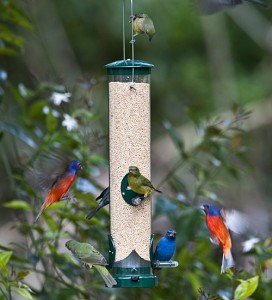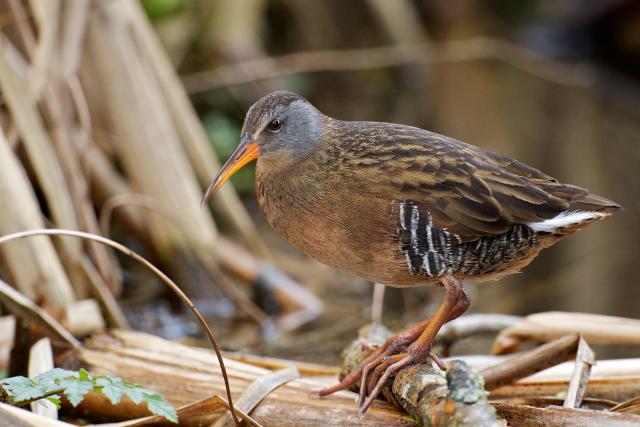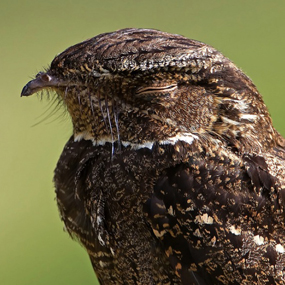For “Winged Wednesday”:
King Rail


“Back in the days before automobiles, the King Rail was called the “stage driver,” since its "chuck-chuck" call reminded listeners of a rider or teamster clucking to his horses. Another folk name for this rail is “marsh hen,” because the bird looks a bit like a long-billed chicken, and marshes are where you will find them—if you’re lucky.
These solitary, elusive birds are more often heard than seen as they forage through their freshwater wetland habitats in search of crustaceans and insects. The King Rail was first scientifically described in 1834 by John James Audubon, and is the largest North American rail, about the size of a crow.
Over the past several decades, the King Rail has declined in population in the northern part of its range, while appearing to remain somewhat stable in most of the southern United States. It is most threatened by the destruction and degradation of wetlands caused by agriculture and other development, pollution, and pesticide contamination. This species often suffers fatal collisions with tall buildings, communications towers, and telephone wires during its nocturnal migrations.
The best hope for the conservation of this species is on public wildlife refuges, where most of the highest quality wetlands are found. Strong wetland protection and pollution laws are also essential to maintain suitable habitat. Within our system of Bird Conservation Regions, ABC protects habitat for the King Rail and many other wetland-dependent bird species.”
Help ABC conserve this and other birds and their habitats!
Listen to a two-minute broadcast about this bird!
Photo: Greg Lavaty, texastargetbirds.com; Range Map, NatureServe
_______
Summer Bird Feeding: the Case For and Against
During summer, male birds such as these indigo and painted buntings are wearing their colorful breeding plumage. Photo by Bernard Friel.
“Should you take your bird feeders down for the summer? The answer may depend on where you live.
I spoke with George H. Harrison, the author of seven books about backyard birding. Harrison told me there’s no evidence that the presence or absence of feeders has altered the migration behavior of any backyard bird species. In addition, he shared four reasons why it’s a good idea to feed birds during summer — especially if, like me, you’re an avid backyard bird-watcher:” More at: http://blog.nwf.org/2013/04/summer-bird-feeding-the-case-for-and-against/
_______
Virginia Rail, By Gregg Thompson
“More frequently heard than seen, the Virginia Rail is a secretive resident of wetlands across North America. What type of adaptations does this bird have for a life in dense vegetation? Hint: it involves its forehead.
Virginia Rails live in wetlands throughout North America, where they are more frequently heard than seen. To adapt to life in dense vegetation, the body of the rail is laterally-compressed (i.e. "thin") and forehead feathers with modified tips to reduce wear. Virginia Rails can swim and fly, but when in trouble members of this family are more likely to run; in fact members of the rail family have the highest ratio of leg muscles to wing muscles of any bird. See other amazing images of this Virginia Rail taken by Gregg Thompson here, here, and here.
Listen to BirdNote shows: "The Elusive Virginia Rail" and "A Virginia Rail on Michigan Avenue."”
_______
An ancient mating dance offers ranchers, grassland birds a lifeline
BURWELL, Neb. — “Under an indigo pre-dawn sky, as a frigid wind whipped across the plains, a half-dozen brown-and-white birds emerged from tufts of dry grass. They emitted a low cooing sound, akin to the hooting of an owl.
Then the greater prairie chickens started their show, scurrying around to mark their territory. When one encroached on another’s turf, the defending animal charged, forcing the interloper to leap in the air with a flurry of feathers. As the birds became more animated, the orange air sacs on each side of their necks swelled, allowing them to make a louder coo known as “booming.”
The entire display had a single intended beneficiary — a female greater prairie chicken that selects the dominant male for mating — that never bothered to appear. It might have been too cold for her. But the birds still had an audience: tourists sitting silently in a pair of parked yellow school buses with their windows cracked open. These humans may represent the prairie chickens’ best chance for survival.
Prairie chickens have roamed the Plains for millennia, but this region is under pressure from competing financial incentives to grow corn and soybeans or pursue wind energy and shale-oil extraction” More at: http://www.washingtonpost.com/national/health-science/an-ancient-mating-dance-offers-ranchers-grassland-birds-a-lifeline/2013/04/21/e79e76c2-a6dd-11e2-8302-3c7e0ea97057_story.html
_______
Eyes to Watch Over You, Bald Eagles.
An Amazing Fact: “Bald eagles primarily eat fish and can live up to 40 years in the wild. Furthermore, they are monogamous and remain faithful to their mate until death. These amazing 
Eagles have two foveae, or centers of focus, in the retina of each eye that allow them to see both forward and to the side at the same time. (Human retinas have only one.) Depending on which way an eagle looks, the lens of its eye focuses an image on one fovea or the other. The rear fovea is for forward, stereoscopic vision, and the other is for looking sideways. Both foveae are more densely lined with rods and cones than those of human eyes, giving them much greater resolving power.
Eagles have color vision, and while their eyes are not as large as a human’s, their sharpness is at least four times that of a person with perfect vision. While soaring, gliding, or flapping, they are capable of seeing fish in the water from several hundred feet above the surface or identify a rabbit moving almost a mile away. An eagle flying in a fixed position at an altitude of 1,000 feet could spot prey as small as a mouse over an area of almost three square miles!”
_______
Radar Tracking Project to Help Protection of Endangered Caribbean Petrel

Black-capped Petrel by Alfred Yan
“While it is well known that communication towers can pose a collision hazard for migratory birds, bird conservationists have long suspected that towers can specifically be harmful to Black-capped Petrels because of their nocturnal behavior and the risk that communications towers pose to other petrel species around the world. Unfortunately, the scientists on the Hispañiola survey expedition recently found out just how harmful.
Two cell phone towers are positioned above the La Visite escarpment near the summit of Tet Kay Jak, a high point in close proximity to one of the known nesting areas for the species in Haiti. During the nights of February 9 and 10, the team monitored these towers as part of their petrel radar surveys in the area. In these two nights, they observed numerous birds striking the guy wires supporting the towers (up to three birds in one 10-minute period), with a number of the petrels becoming grounded. Three were found alive, and the remains of three others were found. Heavy brush near the base of the towers, however, hindered a complete and thorough search. Because petrels fly at high speeds, collision with towers and other structures is likely to result in injuries or death. Disoriented birds, grounded with minor or no injuries, are at risk of predation by animals such as dogs and cats, or may die of dehydration.” More at: http://www.abcbirds.org/newsandreports/stories/130429.html
______
Duluth man watches as waxwings began 'dropping out of the sky'

Wildwoods, a wildlife rehabilitation center in Duluth, is caring for three Bohemian waxwings that were injured downtown in the past two days, said Peggy Farr, a Wildwoods rehabilitator and board member. Five other Bohemian waxwings died in that incident, Farr said.
"We're on a major migration route," said Farr. "This is a good time of year to close the blinds so the birds don't get faked out by the windows."
Separately, about 25 Bohemian waxwings were found dead Monday, April 22, in the plaza area adjacent to the Minnesota Power building in downtown Duluth, said Amy Rutledge, manager of corporate communications for Minnesota Power. The birds apparently had flown into tinted glass partitions adjacent to the building as the birds were flying up to trees. Rutledge said Minnesota Power plans to put stickers on the glass panels that the waxwings hit so birds will be more likely to see the panels.” More at: http://www.twincities.com/minnesota/ci_23100657/duluth-man-watches-waxwings-fly-their-deaths
_______
Weekly Preview: Doves, Cardinals, and Peacocks ...
Upcoming Shows
Mourning Dove. SUNDAY Sunning with Doves by Bob Sundstrom LISTEN NOW ►
Northern Cardinals. MONDAY Voices and Vocabularies -Cardinals' Duet by Bob Sundstrom LISTEN NOW ►
300 East Randolph Building, Chicago. TUESDAY A Building Manager Shows the Way featuring Geoff Credi LISTEN NOW ►
Chuck-will's-widow. WEDNESDAY Voices and Vocabularies: Night Voices - Nightjars by Bob Sundstrom LISTEN NOW ►
Peregrine Falcon. THURSDAY Monitoring the Health Of Coastal Raptors featuring Dan Varland LISTEN NOW ►
Blue Peafowl. FRIDAY Peacocks in India by Dennis Paulson
LISTEN NOW ►
Long-billed Curlew. SATURDAY Long-billed Curlew - Singing over the Grassland by Dennis Paulson LISTEN NOW ►
_______
On This Day:
Great Exhibition opens, May 1, 1851:

______
Empire State Building dedicated, May 1, 1931:

______
An American tops Everest, May 1, 1963:
“James Whittaker of Redmond, Washington, becomes the first American to reach the summit of Mt. Everest, the tallest mountain in the world.

______
Yesterday:
Misty and I had our walk down near Jay’s when we went to pick him up. He wanted me to take him to his bank to cash a check, pay some bills, and hopefully I would get the money that he owes me. (I did get some of it.) We also stopped at Metal Mart, still looking for another source of the white translucent roofing that I want to use on my front porch addition. Theirs was the most expensive yet!

Gummie-cat was left loose in the house while I was gone. I usually put her in my bathroom. She managed to jump high up on a shelf and knock down some duck-shaped baskets. She will probably be exiled to the bathroom when I leave again, as I don’t want her knocking the glasses off the shelves. She will jump up onto anything and has knocked down so many things. She is not content with the high places that I have provided for her. In her former life she was housed in a cat room with several cats and shelves all around, so she doesn’t know any better.
In the afternoon, I heard a loud thump noise which sounded like there might have been a collision at the traffic light near my house. Then I heard it again, it was thunder. It wasn’t long before it really poured, and my screen porch was flooded inside. I will be glad when we get the roof extension on, one of these days.




























1 comment:
You got all the rain over on your way. We just got the outskirts of it.
Post a Comment